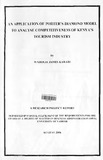| dc.description.abstract | Tourism is the world's largest export earner and an important factor in the balance of payments
of many countries. The tourism industry in Kenya has experienced tremendous growth
contributing to the strengthening of the Kenya shilling against regional and international
currencies. Tourism earnings grew by 27% from Kshs 38.5 billion in 2004 to Kshs 48.9 billion
in 2005. The sector's remarkable performance was attributed to rigorous marketing by
government and private sector.
To achieve competitive advantage for its tourism industry, any country must ensure that its
overall appeal, and the tourist experience offered, must be superior to that of the alternative
destinations open to potential visitors. Existing and potential visitation to any county is
inextricably linked to that country's overall competitiveness, however that is defined or
measured.
The research seeks to capture the main elements of competitiveness as highlighted in the
40
Michael Porter diamond model in his book published in 1998 titled "The Competitive
Advantage of Nations", while appreciating the special issues involved in exploring the notion
of competitiveness as emphasized by tourism researchers. The Porter Diamond model has
framework that can be used to measure the competitiveness of any industry within a nation.
The set of indicators allows identification of the relative strengths and weaknesses of Kenya
tourism industry and can be used by industry and Government to increase tourism numbers,
expenditure and positive economic impacts.
From the study security, advertising and marketing, airports, natural attractions, and pricing,
are the highest rated factors from the tourism stakeholders perspective. While the presence of
tourism clusters, demand by local, science and technology infrastructure, level of rivalry and rail network are at the bottom of the ranking in terms of their contribution to Kenya's competitiveness as a tourist destination.
Finally, recognising the limitations of this study, it is recommended that further research be carried on qualitative aspects, using in depth interviews of the stakeholders. In addition it is recommend that the University of Nairobi and the tourism industry establish formal collaboration where research as this could be used to guide policy by the government considering the importance of tourism in the country's economy. | en |

